SAML IDP#
Overview#
The Gluu Server acts as a SAML identity provider (IDP) to support outbound SAML single sign-on (SSO).
In outbound SAML SSO transactions, external websites or applications (known as a Service Provider, or "SP") redirect users to the Gluu Server for authentication and authorization. Upon successful authentication, the user is redirected back to the SP with personal attributes and an active SSO session.
The following section of the docs explains how to configure the Gluu SAML IDP for SSO.
Note
To support an inbound SAML workflow, where users are redirected to an external IDP for authentication (e.g. Social Login), review the inbound SAML authentication guide.
Trust Relationship Requirements#
The Gluu Server SAML IDP configuration for SSO is called a Trust Relationship (TR). Each TR may require the following infomation:
SP Metadata#
Metadata is an XML file which has configuration data used to establish trust between the SP and IDP. The SP's metadata can be provided as a URL or a separate file. Metadata can change, so a static URL is typically preferred when available.
Attribute Release#
In order to grant access to a protected resource, each SP may require one or more user attributes from the IDP. Required attributes should be specified in the SP's documentation. Attributes can be chosen for release during the creation of each TR, as described below.
IDP Metadata#
The SP may need Gluu's SAML IDP metadata, which can be found at: https://hostname/idp/shibboleth.
Configure NameID#
A NameID or Name Identifier is used to identity the "subject" of a SAML assertion. Some SAML SP's expect a specific SAML NameID Format. The format of NameID can be anything but is typically emailAddress.
There are two ways to create the NameID in Gluu:
oxTrust GUI#
Here is how to configure NameID in oxTrust:
- Create your custom attribute by following this guide.
- Go to SAML -> 'Configure Custom NameID'
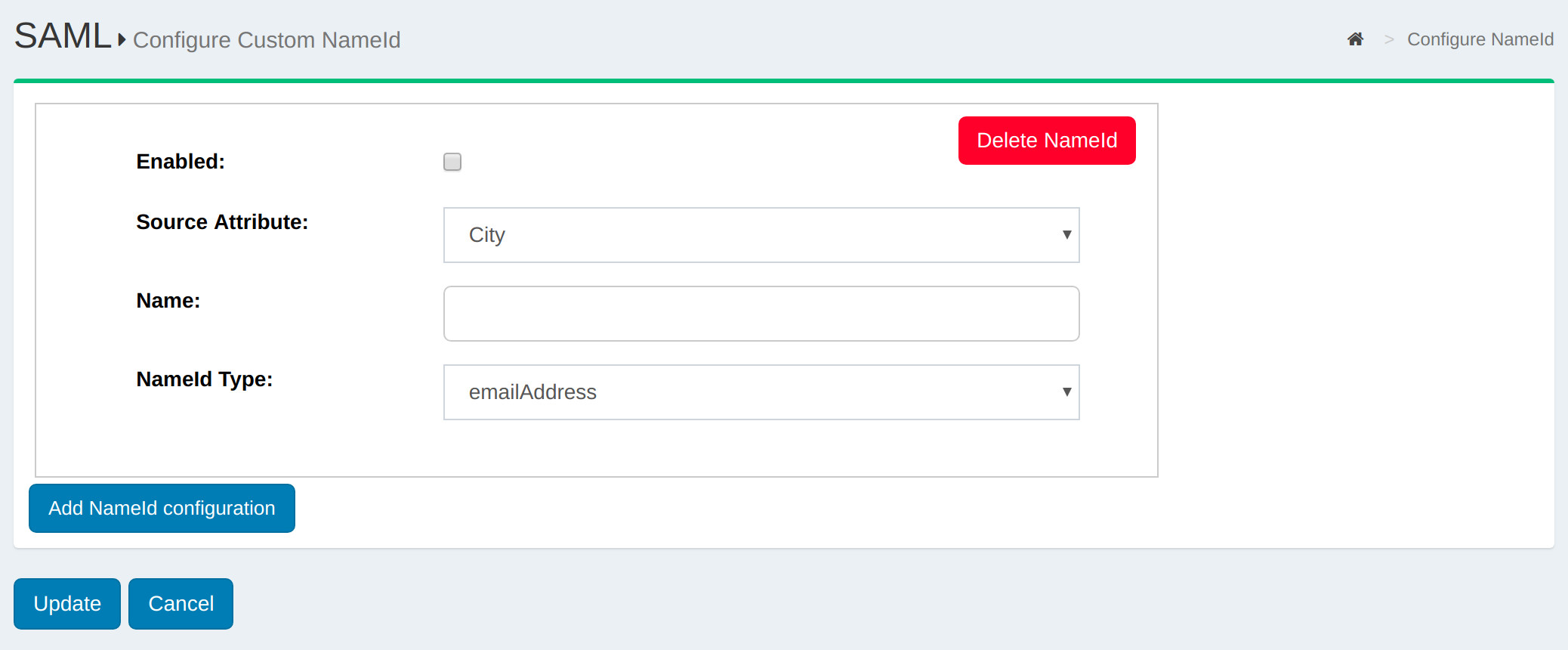
- 'Enable'
Create NameID - 'Attribute Base': Attribute value to calculate name Identifier.
- 'Attribute Name': Custom attribute name which we created earlier here.
- 'Attribute Type': Type of name identifier:
emailAddress,unspecified, orpersistent
- Restart
identityandidpservices by: service identity stop/startservice idp stop/start
Manual Configuration#
It's also possible to configure NameID through configuration file / velocity templates. The template file for NameID definitions are located in the attribute-resolver.xml.vm file under /opt/gluu/jetty/identity/conf/shibboleth3/idp/.
The example below adds customTest, which we created earlier here, as NameID based on UID attribute. The following are put into the attribute-resolver.xml.vm file.
- Add declaration for the new attribute
#if( ! ($attribute.name.equals('transientId') or $attribute.name.equals('persistentId') or $attribute.name.equals('customTest') ) ) - Add definition for the new attribute
<resolver:AttributeDefinition id="customTest" xsi:type="Simple" xmlns="urn:mace:shibboleth:2.0:resolver:ad" sourceAttributeID="mail"> <resolver:Dependency ref="siteLDAP"/> <resolver:AttributeEncoder xsi:type="SAML2StringNameID" xmlns="urn:mace:shibboleth:2.0:attribute:encoder" nameFormat="urn:oasis:names:tc:SAML:2.0:nameid-format:email" /> </resolver:AttributeDefinition> - Update /opt/shibboleth-idp/conf/saml-nameid.xml to generate SAML 2 NameID content
<bean parent="shibboleth.SAML2AttributeSourcedGenerator"
p:format="urn:oasis:names:tc:SAML:2.0:nameid-format:email"
p:attributeSourceIds="#{ {'customTest'} }"/>
service identity/idp stop
service identity/idp start
Create a Trust Relationship#
Follow these instructions to create a SAML TR in your Gluu Server:
- Go to
SAML>Trust Relationships - Click on
Add Trust Relationship - A new form will appear where you can provide all required information to create a Trust Relationship (TR).
- Click the
Addbutton in the lower left corner to save the TR.
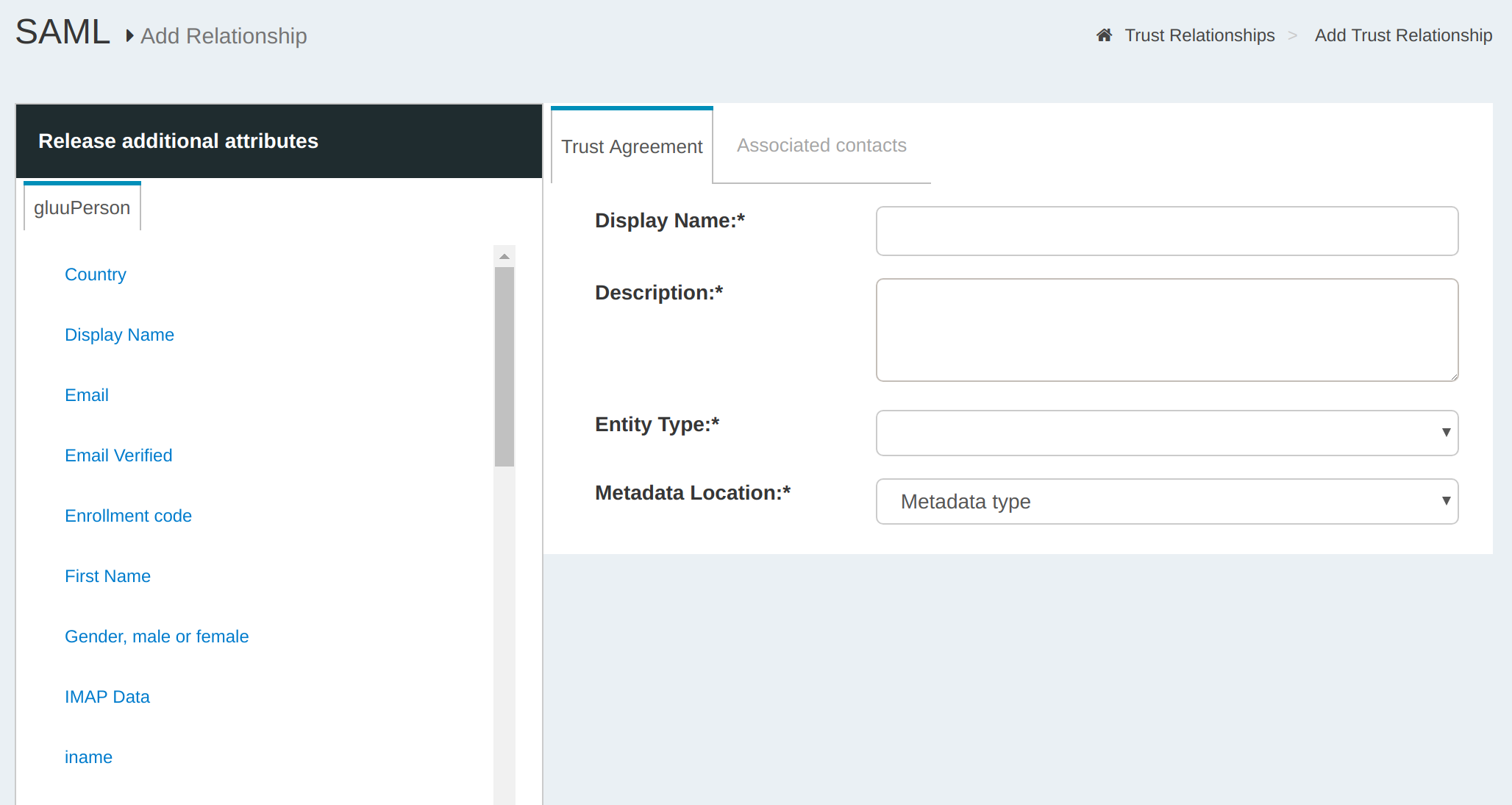
A description of each TR creation field follows:
- Display Name: Name of the Trust Relationship (it should be unique for every TR)
- Description: Purpose of the TR and an SSO link can be added here
- Entity Type: You have two options to choose for entity type.
- Metadata Location: There are four available options to choose from. The correct Type depends on how the SP is delivering Metadata to your IDP
- File: Choose
Fileif the SP has provided an uploadable metadata document in XML format. - URI: Chose
URIif the SP metadata is hosted on a URI that is accessible from the Internet. - Federation: Choose this option if the target application (SP) is affiliated with a federation service (e.g. InCommon, NJEdge etc.). Fedeartion's TR must be created first for it to appear in this list. Learn more about working with a federation below.
- File: Choose
- Released: The SPs required attributes must be added to this panel. The required attributes can be selected from the menu on the left with the heading “Release Additional Attributes”.
Warning
If the Entity Type is Federation/Aggregate, all selected attributes will be released to every SP that relies on the Federation. Therefore, attributes should only be released to Federations when absolutely required.
IDP-initiated outbound SAML flow#
A regular outbound SAML flow starts at an SP. The user is redirected to an IDP with a SAML request, and is then sent by the IDP to the SP's ACS endpoint with a SAML response. A shortened version of this flow is called "IDP-initiated" (or "unsolicited"). It starts with the IDP sending a SAML response to the SP when no prior SAML request was made.
To configure this SAML flow, follow these steps:
- Add a TR for the SP using the standard procedure described above. Wait until the updated configuration is re-loaded by the IDP.
- Craft a URL like this:
https://idp.gluu.host.loc/idp/profile/SAML2/Unsolicited/SSO?providerId=https%3A%2F%2Fsphost-shib.site%3a8443%2Fshibboleth, where:idp.gluu.host.locis the DNS name of the target Gluu ServerproviderIdURL query parameter contains theentityidof the target SP
- Send the user to the composed URL (e.g. via redirection by on-page JS, an action triggered by a button, etc.)
The user should gain immediate access to the protected resource, with no further redirects or authentication.
Relying Party Configuration#
Through the Relying Party configuration you can customize how different IDP profiles will respond to requests received from the SP, including encryption and digital signature options. The underlying IDPs functionality is described in the Shibboleth wiki.
The "Configure Relying Party" checkbox is accessible on the TR creation page and must be enabled with a specific profile(s) selected as active for this TR to generate a valid configuration. In most cases, just adding the SAML2SSO profile with default settings will suffice.

Setting the checkbox will result in a link which, if clicked, will summon a list of profiles currently available for customization. Each entry in the list has a brief description of its purpose and a selection of settings for which custom values may be chosen, as can be seen on image below.
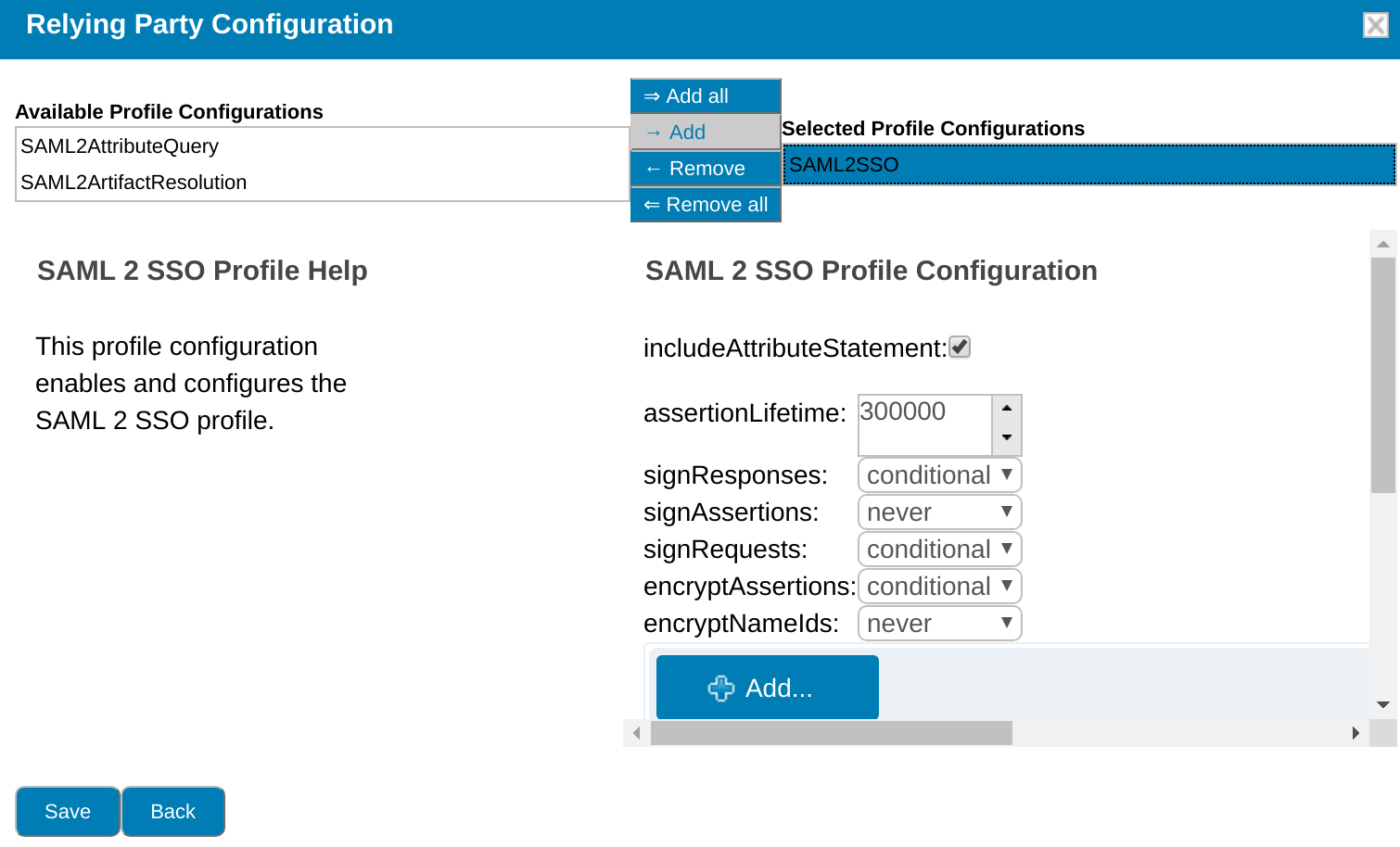
oxTrust allows you to tweak a limited subset of profiles mentioned in the Shibboleth wiki. The SAML2SSO profile is the most commonly used browser SSO profile.
| Profile | Configuration Wiki Link |
|---|---|
| SAML2SSO | https://wiki.shibboleth.net/confluence/display/IDP30/SAML2SSOConfiguration |
| SAML2Logout | https://wiki.shibboleth.net/confluence/display/IDP30/SAML2LogoutConfiguration |
| SAML2AttributeQuery | https://wiki.shibboleth.net/confluence/display/IDP30/SAML2AttributeQueryConfiguration |
| SAML2ArtifactResolution | https://wiki.shibboleth.net/confluence/display/IDP30/SAML2ArtifactResolutionConfiguration |
SAML Single Logout#
Gluu Server supports SAML2 single logout if enabled by the administrator. To enable, create a SAML2Logout RP profile with the following configuration:
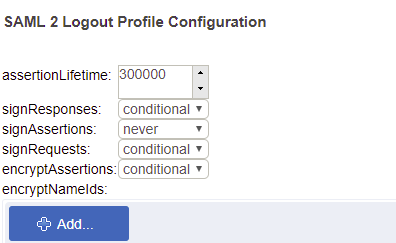
Once enabled, the user can be directed to https://[hostname]/idp/Authn/oxAuth/logout when they wish to log out. The user will be directed to a confirmation page.
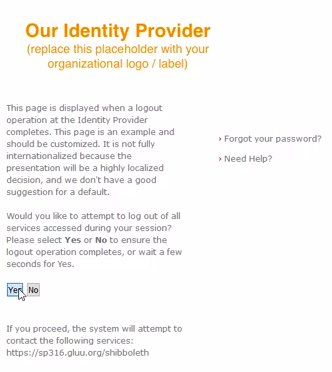
If the user clicks Yes or just waits a few seconds, the session will be killed and the user will be logged out.
Federation Configuration#
If your target SP is part of a federation like InCommon, a TR can be created for the SP using the federation's metadata. To achieve this, add a TR for the federation in the Gluu Server first, then create TRs for each target SP in the federation.
The example below shows how to add a TR for InCommon.

Once a TR has been established with the federation, TR's can be configured for any SP in the federation by selecting the federation from the Federation Name, then selecting the entity-id for the SP.
In the example below, we are creating a TR for the 'Internet2 Wiki', which is an InCommon Federation affiliated SP (meaning, the SPs entityID is available in InCommon metadata).
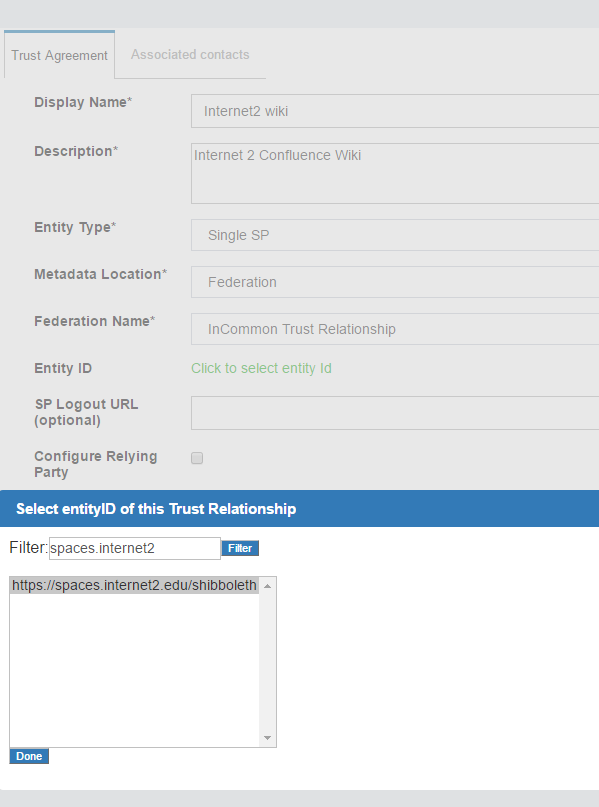
Force Authentication#
The Gluu Server supports force authentication out-of-the-box. Including ForceAuthn=true in the initial SAML request from the SP signals to the IDP that the user must reauthenticate, even if they already have a valid session at the server. This feature can be used to verify the user's identity prior to granting them access to highly protected resources.
Upon receiving the SAML request with this flag, the IDP will invalidate its session for the user, then will issue a new OpenID Connect (OIDC) authorization request to oxAuth, including the prompt=login parameter. This parameter forces oxAuth to invalidate its session as well. The user will then follow the full authentication procedure.
SAML SP#
If your target application (SP) does not already support SAML, we recommend using the Shibboleth SP web server filter to secure and integrate the application with your Gluu SAML IDP.